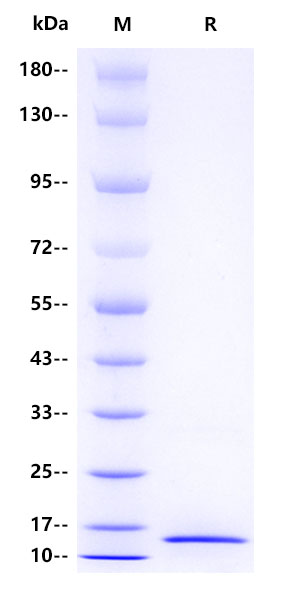Protein sequence(P06702, Met1-Pro114, with C-10*His)
MTCKMSQLERNIETIINTFHQYSVKLGHPDTLNQGEFKELVRKDLQNFLKKENKNEKVIEHIMEDLDTNADKQLSFEEFIMLMARLTWASHEKMHEGDEGPGHHHKPGLGEGTPGGGGSHHHHHHHHHH
>95% by SDS-PAGE
12 months from date of receipt, -20 to -70 °C as supplied. 6 months, -20 to -70 °C under sterile conditions after reconstitution. 1 week, 2 to 8 °C under sterile conditions after reconstitution. Please avoid repeated freeze-thaw cycles.
S100A9 is a member of the S100 family of proteins containing 2 EF hand calcium-binding motifs. S100 proteins are localized in the cytoplasm and/or nucleus of a wide range of cells, and involved in the regulation of a number of cellular processes such as cell cycle progression and differentiation. S100 genes include at least 13 members which are located as a cluster on chromosome 1q21. This protein may function in the inhibition of casein kinase. Intracellular S100A9 alters mitochondrial homeostasis within neutrophils. As a result, neutrophils lacking S100A9 produce higher levels of mitochondrial superoxide and undergo elevated levels of suicidal NETosis in response to bacterial pathogens. Furthermore, S100A9-deficient mice are protected from systemic Staphylococcus aureus infections with lower bacterial burdens in the heart, which suggests an organ-specific function for S100A9.
Immobilized S100A8, Human at 20 μg/mL (50 μL/well) can bind Human Calprotectin (S100A9), His tag with EC50 of 0.645-0.720 μg/ml.

2μg(R: reducing conditions)